

Ryokan (Japanese-style)
Traditional Japanese inn. A stay at Ryokan requires
following a few rules that differ from those at a Western-style hotel.
<Exterior >
| Ryokan is the traditional accommodation of Japan featuring age-old interior design and personalized services. It is not always possible to tell a Ryokan by its exterior. Exterior of Ryokan can be either wooden and of traditional architectural design (See photo 1), or otherwise mortar or ferro-concrete in international design (See photos 2 and 3). The exterior of the latter does not differ greatly from that of Western-style hotels. Welcome Inn Ryokans are mostly small and family-run with less than 30 rooms. |
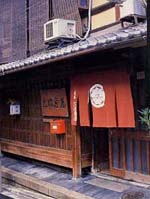 |
|
photo 3
|
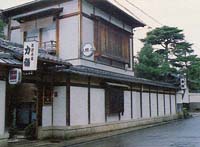 |
 |
|
photo1
|
photo 2
|
<Entrance>
| The front portal and the rooms in Ryokan often have sliding doors (See photo 3). To enter a Ryokan, guests take their shoes off at the entrance hall (See photo 4) and wear slippers while in its hallways. The slippers should be left outside the tatami-matted room. |
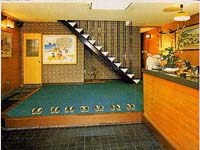 |
|
photo 4
|
<Typical Ryokan Room>
 |
A room in a Ryokan is usually a single undivided
room floored with traditional rice-straw tatami matting.
It functions as a living room during the day and as a bedroom during
the night with comfortable futon bedding being laid out (See
photo 5). There are connecting rooms which are suited for a traveling
family but functions of connected rooms are not different. There
are also rooms which are partly western with a bed (See photo 6).
Some rooms have their own miniature garden (See photo 7).
|
|
photo 5
|
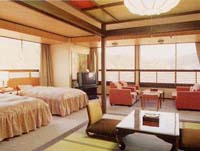 |
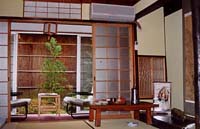 |
|
photo 6
|
photo 7
|
<Bath and Toilet>
|
Bath and toilet facilities are often separate from the room and are shared by staying guests unless otherwise specified (See photo 8). Ryokan usually loans a clean cotton yukata which serve as a bathrobe and as well as a pajama, and provides a small towel which a guest can keep. |
 |
|
photo 8
|
<Dining>
The rates at a Ryokan often include two meals but the
rates at those registered Welcome Inns do not include meals, giving you
some flexibility. Ryokan have a dining room where the guests, if
they choose to, take breakfast and dinner (See photo 9). If you would
like to have dinner at your own room, that may or may not be arranged
depending on the establishment.
|
|
 |
|
photo 9
|
photo 10
|
Minshuku (Japanese-style)
|
Minshuku are small family-run inns operated within
private homes. Originally developed to provide extra accommodations
in vacation areas during high travel seasons, minshuku are homey
in atmosphere and feature moderate rates. You can enjoy the close-up
view of Japanese life that these minshuku offer. Otherwise, you
can expect minishuku to be exactly like Ryokan. |
 photo 11  |
|
photo 12
|
Kokumin Shukusha or People's Lodges
|
|
Kokumin Shukusha are moderate-rated lodgings mostly
built in National Parks or nearby with the aim of providing the
nation with an opportunity to enjoy an inexpensive form of recreation
in a select natural environment. Some of them are those built by
local government, while others are privately managed and designated
as such by the National Park Association.
|
|
photo 13
|
<Exterior>
Most kokumin shukusha have an exterior in international style and have
an appearance of a western-style hotel.
<Entrance>
At most kokumin shukusha, guests take their shoes off at the entrance
hall and wear slippers in the hallways.
<Guest Room >
Rooms are mostly in Japanese style with traditional rice-straw tatami
matting. Guests are asked to fold up their futon bedding in the
morning and stow it away in closet.
< Bath and Toilet >
Bath and toilet facilities are usually separate from the room and are
shared by staying guests. Kokumin Shukusha loan a yukata cotton robe but
do not provide a towel.
< Dining >
Breakfast and dinner, if you order them, are served in a large dining
hall.
Business Hotel (Western-style)
|
Business Hotels (Western-style), as their name implies, were originally designed to cater to budget-minded business travellers. They are run in a business-like fashion. They minimize nonessentials so as to make their rooms available at reasonable prices. Their rooms are compact but clean. There is no room service but they provide vending machines for drinks and snacks in addition to one or more restaurants on the premises. Furniture is Western-style with a private bath as a general rule. Yukata cotton robes and towels are provided to their guests. In keeping with the emphasis on efficiency for business travellers, most of them are conveniently located in city centers. |
 |
|
photo 14
|
Pension (Western-style)
|
Pensions, often called "Western-style minshuku", are small family-run establishments with Western-style facilities. They have been developed essentially to satisfy a demand among Japanese people for good, inexpensive Western-style room and board in scenic areas. Outdoor sporting facilities are usually available nearby. Guests may be asked to take off their shoes at the entrance and use slippers. |
 |
|
photo 15
|

